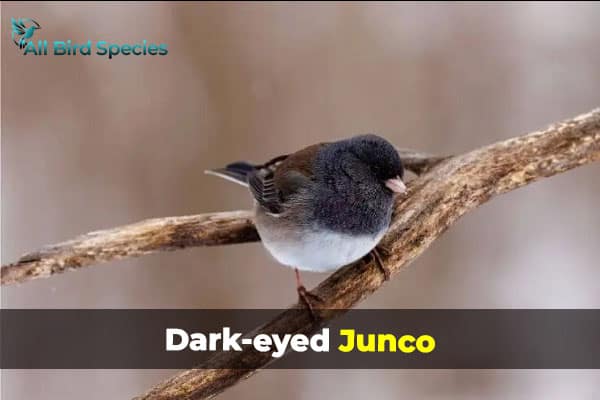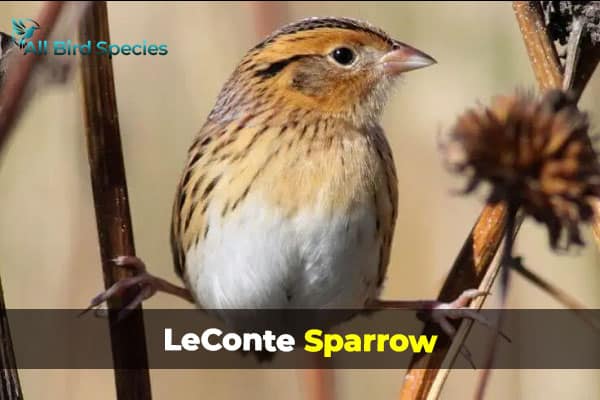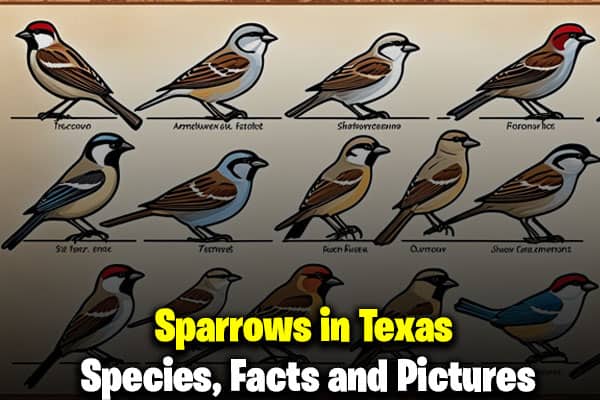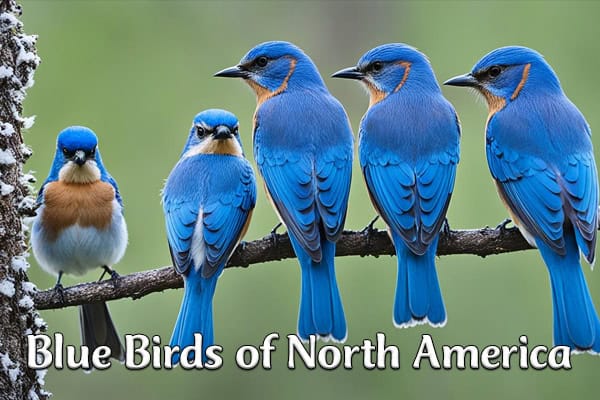Types Of Sparrows in Texas: Species, Facts and Pictures
Did you know Texas has over 28 types of sparrows? This shows how diverse the state’s sparrow species are. It’s a haven for birdwatchers and nature lovers.
This guide will show you the unique traits, homes, and ways of these birds. Learning about sparrows in Texas makes wildlife watching more fun. It also helps us value the state’s diverse ecosystems.
Common Sparrows You Can Find in Texas
Texas is home to many common sparrows, each with its own look and place in nature. Learning about Common Texas sparrows helps us appreciate our local birds more. Here, you’ll learn about three important species.
House Sparrow
- Scientific name: Passer domesticus
- Life span: 3-5 years
- Size: 14-16 cm
- Weight: 30-40 g
- Wingspan: 20-23 cm

The House Sparrow (Passer domesticus) came from Europe and now lives in Texas cities. It’s easy to spot because of its bright chestnut and gray feathers. This bird loves to be around others and is often seen in big groups.
It’s good at living in cities and can be found near people’s homes. This makes it compete with native birds for food and shelter.
Song Sparrow
- Scientific name: Melospiza melodia
- Life span: 2-7 years
- Size: 14-18 cm
- Weight:22-40 g
- Wingspan: 23-25 cm

The Song Sparrow (Melospiza melodia) is known for its beautiful singing. It has brown and rust-colored feathers. You can find it in Texas in places with lots of bushes and meadows.
It likes to make its home close to the ground. In spring, its song fills the air, making the area sound more alive.
Dark-eyed Junco
- Scientific name: Junco hyemalis
- Life span: 3-7 years
- Size: 14-16 cm
- Weight: 20-30 g
- Wingspan: 19-25 cm

The Dark-eyed Junco (Junco hyemalis) is a gray bird that visits Texas in the winter. It’s active and loves to search for seeds on the ground. This bird can live in many different places, making it a common sight in the state during the cold months.
| Species | Scientific Name | Habitat | Distinctive Features |
|---|---|---|---|
| House Sparrow | Passer domesticus | Urban areas | Chestnut and gray plumage |
| Song Sparrow | Melospiza melodia | Shrubby areas, meadows | Brown and rust streaked plumage; melodious song |
| Dark-eyed Junco | Junco hyemalis | Various habitats | Slate-gray color; feeds on seeds |
Unique Characteristics of Sparrows in Texas
Sparrows in Texas have many special features that help them live in different places. Their feathers come in many colors, which is very important for hiding from predators. This helps them stay safe.
These birds also have special behaviors that help them survive. For example, they make beautiful sounds to find a mate or mark their territory. You can hear their songs at dawn and dusk, making the Texas landscape more lively.
Learning about these special traits makes it easier to tell sparrows apart. When you go birdwatching in Texas, knowing these differences will make your experience more fun. It lets you see how amazing these birds are.
| Characteristic | Description |
|---|---|
| Plumage Coloration | Varies among species, aiding in camouflage |
| Singing Abilities | Used for mating calls and territorial defense |
| Behavioral Patterns | Vary based on habitat, enhancing survival chances |
| Size Range | Small to medium, affecting flight patterns and agility |
Habitat Preferences of Texas Sparrows
Texas is home to many sparrow species. These birds adapt well to their environments. They live in cities, grasslands, and wetlands, each with their own habits.
Urban Settings
In cities, urban sparrow species are easy to spot. House Sparrows love living in buildings and man-made places. They find food near people, making them common in city parks and sidewalks.
Grasslands and Shrublands
Chipping Sparrow and Savannah Sparrow like open fields and shrubs. These places offer lots of seeds and insects to eat. The thick plants help sparrows hide from predators while they look for food and a place to nest.
Wetlands
Wetland sparrows, like the Swamp Sparrow, live in wet areas with lots of marshy plants. These places meet their needs for nesting and finding food. The tall reeds and grasses protect them from danger.
| Habitat Type | Common Species | Nesting Preferences |
|---|---|---|
| Urban Settings | House Sparrow | Buildings, eaves, and bridges |
| Grasslands and Shrublands | Chipping Sparrow, Savannah Sparrow | Ground nests in shrubbery |
| Wetlands | Swamp Sparrow | Nests in dense marsh vegetation |
Diet and Foraging Habits of Sparrows
Sparrows eat a mix of seeds, insects, and berries. This mix helps them live well in different places across Texas. They show how flexible they are by using different ways to find food. Some sparrows dig through leaves, while others pick seeds right from the plants.
Some sparrows, like the House Sparrow, find food in cities. They look for food scraps and seeds left behind by people. But, those living in grasslands mostly use their natural food sources. This shows how they can adjust to different places, helping keep the balance in their ecosystems.
The different ways sparrows find food shows how important they are to nature. By eating seeds and insects, they help spread seeds and keep insect numbers in check. Watching these behaviors can make you appreciate these small but big creatures more.
Nesting Behaviour of Texas Sparrows
Sparrows have unique ways of building their nests. They use different materials and places for their nests. This helps them survive and protect their young.
Types of Nests
Sparrows make various nests based on what they find around them. Here are some common types:
- Cup-shaped nests are made from grasses, leaves, and twigs.
- Ground nests that offer protection from aerial predators.
- Tree or shrub nests that blend into the foliage for safety.
Nesting Locations
In Texas, sparrows choose different places to nest. They might pick:
- Dense vegetation areas for better camouflage.
- Open areas for easy food access.
- Urban spots for human-made structures.
| Nest Type | Common Materials | Protection Level |
|---|---|---|
| Cup Nest | Grasses, twigs, feathers | Moderate |
| Ground Nest | Grasses, leaves | High |
| Tree/Shrub Nest | Twigs, leaves, mud | Variable |
Each sparrow species has its way of nesting. By studying their habits, we learn about their lives in Texas.
Identification Tips for Sparrows in Texas
Identifying sparrows can be fun. With many species in Texas, knowing how to spot them can make birdwatching better. Look at their looks and sounds to get better at identifying sparrows. Here are some tips to help you spot sparrows on your birdwatching trips.
Physical Characteristics
When watching sparrows, notice their key features. These can help tell one species from another:
- Coloration: Look for unique colors that differ between species. Some sparrows have streaked patterns, while others are more uniform.
- Size: Sparrows come in different sizes, from very small to quite large. Comparing them to other birds can help.
- Markings: Take note of their head, wing, and back markings. Some have distinct facial or wing bars.
Song and Call Identification
Listening for sparrow calls is key to identifying them. Each sparrow has its own call, which helps with identification. Here are tips for recognizing sparrows by their songs:
- Pitch: Notice the call’s pitch; some are high-pitched, others deep.
- Rhythm: See the rhythm and pattern of their songs. Some have a repetitive structure that makes them easier to spot.
- Duration: Remember how long the calls last. Short, quick notes might mean one species, while longer melodies another.
Using both what you see and hear can improve your sparrow-spotting skills. Keep these tips in mind as you explore the outdoors.
Seasonal Changes and Migration Patterns
Learning about the seasonal behavior of sparrows is key to enjoying these lovely birds in Texas. Many species change a lot during the year. This is due to temperature and food changes. These changes lead to interesting sparrow migrations you can see.
In Texas, many sparrows move south to get away from cold winter. They go to warmer places with more food. Wintering sparrows are common in the south, living in big groups. Look for them in fields and gardens where food is easy to find.
Spring brings a change as sparrows come back. They make new homes and get ready for babies. This time is great for bird watchers. Knowing when sparrows move helps you see different kinds all year.
| Season | Sparrow Activity | Common Species Observed |
|---|---|---|
| Winter | Gathering in flocks | Dark-eyed Junco, American Tree Sparrow |
| Spring | Return migration, territory establishment | Song Sparrow, House Sparrow |
| Summer | Nesting | Field Sparrow, Cassin’s Sparrow |
| Fall | Preparation for migration | Vesper Sparrow, Savannah Sparrow |
Watching these seasonal changes makes bird watching in Texas more fun. You’ll see different sparrows in every season. Enjoy the beauty of sparrows moving and learn to love these amazing birds.
Threats and Conservation Efforts for Sparrows
Sparrows are small but important birds in our world. They face many challenges that threaten their numbers. By understanding these threats, we can work better to protect them and their homes.
Habitat Loss
Urbanization and farming are big threats to sparrows. As cities grow, the places sparrows need for living and finding food get smaller. This means fewer sparrows because they don’t have enough space or food.
Invasive Species
Non-native birds also harm sparrows. Birds like the House Sparrow take over their homes and food. This makes it hard for native sparrows to survive.
We need to protect natural areas and control invasive birds to help sparrows. Working on restoring habitats and managing invasive birds is key to keeping sparrow numbers up.
| Threat | Description | Conservation Approach |
|---|---|---|
| Habitat Loss | Reduction of nesting and feeding areas due to urbanization and agriculture. | Habitat restoration and preservation initiatives. |
| Invasive Species | Competition from non-native species for resources. | Management and control programs for invasive bird populations. |
Rare and Uncommon Sparrows of Texas
Texas is home to many rare sparrows that are hard to find. Watching these birds can be a fun challenge. We will look at three sparrows: the Field Sparrow, LeConte’s Sparrow, and Cassin’s Sparrow. Knowing about their looks and where they live helps us appreciate these birds more.
Field Sparrow

The Field Sparrow lives in open fields and shrublands. You can hear its soft song in the spring. It’s small, with a pink bill and a white eye ring. Seeing one is a treat for bird lovers.
LeConte’s Sparrow

The LeConte’s Sparrow is hard to spot. It likes wet meadows and tall grasses. It hides a lot until it feels threatened. Its unique look and call make it exciting to see.
Cassin’s Sparrow

The Cassin’s Sparrow lives in dry places like grasslands and brushy areas. It sings a soft, haunting song. It’s hard to see because it blends in well, making it a rare find in Texas.
| Species | Habitat Preferences | Identification Features | Notable Behaviors |
|---|---|---|---|
| Field Sparrow | Open fields, shrublands | Pink bill, white eye ring | Melodic song during breeding |
| LeConte’s Sparrow | Wet meadows, tall grasses | Streaked plumage, distinctive call | Elusive, often remains hidden |
| Cassin’s Sparrow | Arid grasslands, brushy areas | Soft, streaked feathers | Haunting song, blends well into surroundings |
Exploring Sparrows in Texas
Exploring sparrows can lead to fun experiences. Birdwatching in Texas lets you connect with nature and see the beauty of these small birds. You can find sparrows in many places, from city parks to wide open fields.
To make watching sparrows better, try these tips:
- Visit places like urban gardens, beaches, and wetlands.
- Go out early in the morning or late in the afternoon when sparrows are busy.
- Bring binoculars for a closer look and a field guide to help identify different types.
Wherever you go in Texas, you’ll find the joy of watching sparrows. Watching them helps you learn about these interesting birds and connect with nature. Birdwatching in Texas is about seeing different birds and enjoying the peace of being outside.
Conclusion
As we finish our look at Texas sparrows, we see how important they are to our region’s nature. They have unique traits and live in different places. This makes them key to understanding Texas’s rich wildlife.
Watching birds in your area is very important. It brings peace and connects you to nature. By watching sparrows and other birds, you learn about their lives and how they help our world.
It’s also key to protect sparrows for a healthy Texas environment. You can help by joining local groups and supporting nature. Doing this helps make sure sparrows will still be around for others to enjoy in the future.







